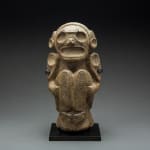Taino Zemi Sculpture, 1200 CE - 1500 CE
Stone
26.7 x 12.1 cm
10 1/2 x 4 3/4 in
10 1/2 x 4 3/4 in
BF.041
Further images
This intriguing stone sculpture is a zemi – the physical incarnation of a Taino god, spirit or ancestor. These were used by families and centralized magico-religious institutions on a village...
This intriguing stone sculpture is a zemi – the physical incarnation of a Taino god, spirit or ancestor. These were used by families and centralized magico-religious institutions on a village scale, in order to “…help women with child…many which speak, and others that make grow the things that they eat, and others that bring rain, and others that make the wind blow” (Arrom 1974: 26). Historical accounts by Columbus, among others, also confirm a fertility role for at least some of the pieces. Identifying specific pieces with specific gods or spirits is not always possible; the pantheon of gods is fairly well established (based around Yucahu – the god of cassava, the Taino staple crop – and his mother Antabey, who is responsible for fertility and water) but their physical appearances are generally undefined. Zemis have been found in various parts of the Caribbean, especially Hispaniola and Jamaica.
Large-scale zemi figures in stone, wood and shell were commissioned by Taino chieftains (caciques) and stored in temple-like structures. Smaller, amulet-like, versions such as this one may have been owned by a wider section of society. The detail of the carving however, especially on the reverse, confirms that this was a high status object with a talismanic function. The zemi is depicted in a ritual squatting position with his knees raised up towards his chest and his feet pointing inwards at an improbable angle. The position of the hands, which clutch the thighs, also recalls the pose adopted by Taino shamans during the cohoba rituals. According to Taino beliefs, shamans were able to communicate with the souls of deceased ancestors when they entered into a trance-like state induced by the hallucinogenic cohoba. The facial features are skeletal, with circular sunken orbits, snout-like nose and gaping mouth. The incised geometric motifs across the bridge of the nose and on the lower legs may well reflect the design of tattoos or textiles worn by the Taino elite. This fascinating object is desirable for its aesthetic merits alone, but also offers is a unique insight into the religious practices of the Taino. (AM)
Large-scale zemi figures in stone, wood and shell were commissioned by Taino chieftains (caciques) and stored in temple-like structures. Smaller, amulet-like, versions such as this one may have been owned by a wider section of society. The detail of the carving however, especially on the reverse, confirms that this was a high status object with a talismanic function. The zemi is depicted in a ritual squatting position with his knees raised up towards his chest and his feet pointing inwards at an improbable angle. The position of the hands, which clutch the thighs, also recalls the pose adopted by Taino shamans during the cohoba rituals. According to Taino beliefs, shamans were able to communicate with the souls of deceased ancestors when they entered into a trance-like state induced by the hallucinogenic cohoba. The facial features are skeletal, with circular sunken orbits, snout-like nose and gaping mouth. The incised geometric motifs across the bridge of the nose and on the lower legs may well reflect the design of tattoos or textiles worn by the Taino elite. This fascinating object is desirable for its aesthetic merits alone, but also offers is a unique insight into the religious practices of the Taino. (AM)









